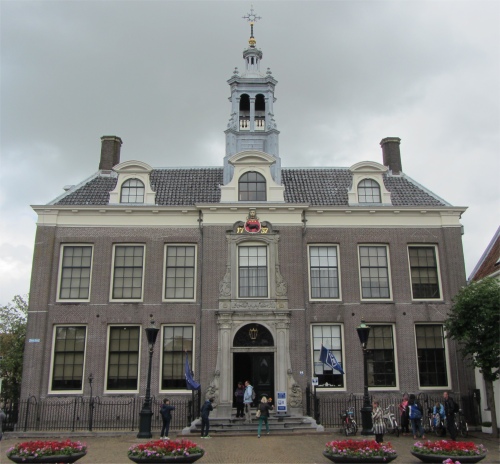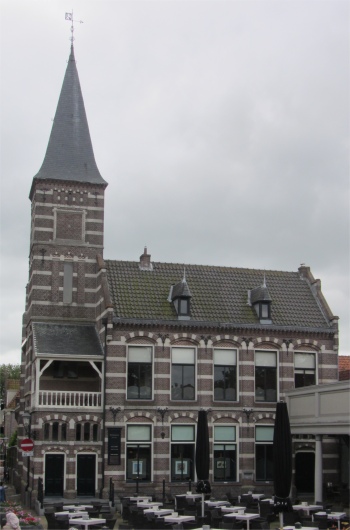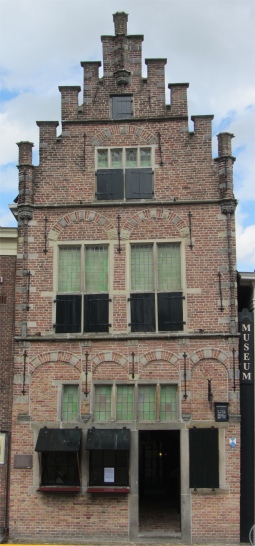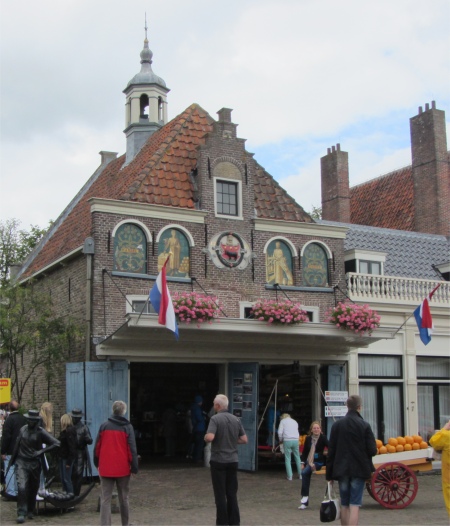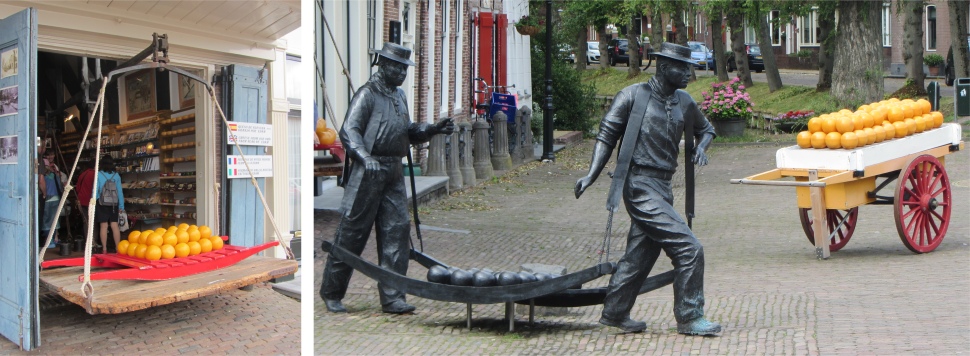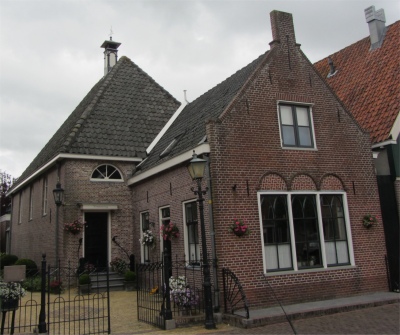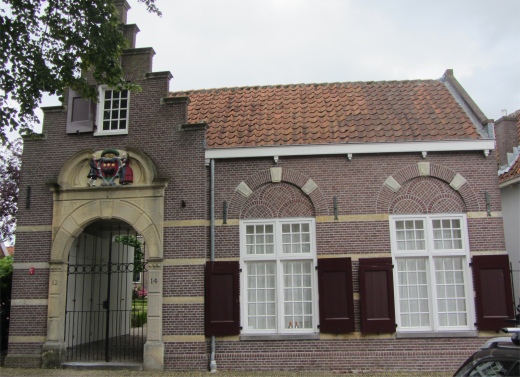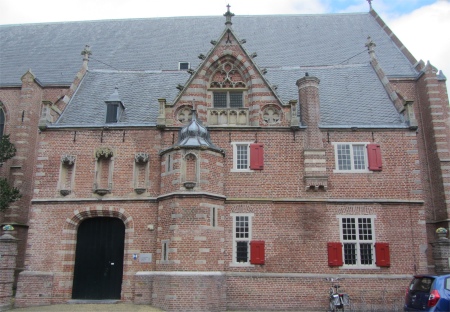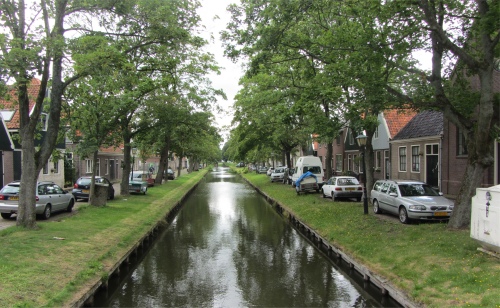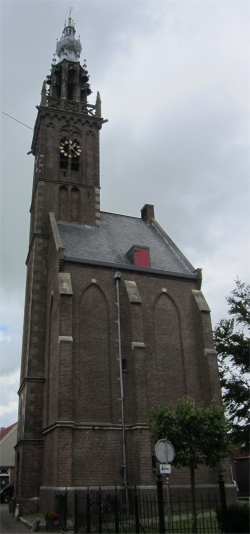
Oldest Wooden Building
|
We stood on the broad bricked-over canal covering of the Dam and took stock of what lay around us in the square. On our eastern side, behind large saucer-shaped pots of flowers, stood the stately Town Hall. Built in 1737, this imposing building that presided over the square displayed the Edam coat-of-arms above the Louis XIV style doorway.
To the south of us was the former Post Office, designed by C. H. Peters, architect of Amsterdam. He was a student of P. J. H. Cuypers, designer of the Rijksmuseum and Central Station. The buildings neo-renaissance influences, light sandstone stripes and tower did follow a theme seen in the capital's buildings.
Looking to the north of the Dam, we observed the oldest brick house in the town. Built around 1530 as a private dwelling, it was furnished as a museum in 1859. Natural stone, profile of the pinnacles and its asymmetry gave the step gable its late gothic character. Sadly we did not have time to look around the museum, though I would have loved to see its famous floating cellar; a brick box-shaped room, floating freely on the ground water. According to folklore it was built by a sea captain who missed the sea. Crumbs, why didn't he just opt for a house boat?
Departing the Dam, we stepped back in time by walking along charming, cobblestone streets to the Cheese Market, where we indulged in sampling fresh cheeses made daily, Edam being noticeably softer and creamier than Gouda. As in Alkmaar, during market days, cheese was sold in a colourful manner employing straw-hatted cheese carriers carrying the cheeses on wooden barrows, between 1778 and 1922. The Waag with its stunning painted facade dated from 1778. Sadly, although farm cheese (Boerenkaas) can occasionally be found, nowadays most Edam cheese is produced in factories. Small groups of people posed around the square for those time immemorial snaps such as gran pushing a cheese barrow, a child sitting on the scales etc.

A Trio of "Gapers" in the Chemist Shop, Similar to the One We Saw in Haarlem
|
Opposite the Cheese Market stood the meeting place of the Doopsgezinde Gemeente (Mennonite Church). In 1702, this clandestine building was built back from the building line, since then regulations stated that a Baptist church could not be built on public roads. In early 1500, there were inhabitants of Edam who adhered to the doctrine of the Anabaptists. These Anabaptists were the forerunners of today's Mennonites, and longed to return to the early Christian church, which existed before the Roman Catholic Church played its dominant role. In my more naive moments, I often wonder that over thousands of years, it has not been twigged yet that the thousands of disputes between disparate religious groups may be due to the groups being headed up by disparate individuals with their own aloof ideas of what religion is all about or their own hidden agendas - hey that's my naive view.

Cheese Warehouses
|
We headed up Matthijs Tinxgracht, passing the gatehouse to a former Protestant orphanage, the Weeshuis. Today it houses a few offices.
We strolled along the tree-lined stretch of water up to the Grote Kerk or St. Nicolaaskerk, named after the patron saint of seafarers, merchants and children; Edam was full of seafarers and merchants. This enormous church was of cathedral dimensions and totally dominated the northern end of the town. Its size is explained by the fact that when the town's economy was booming as trade increased, the church was intended to represent Edam's affluence and riches. It is thought to have been founded at the beginning of the 15th century, and suffered two extensive fires in 1602 and 1699, both of which had apparently been caused by lightning strikes on the tower. As a consequence, when the church was rebuilt the height of the tower was purposely reduced.
We entered this grand building below the tower, and found ourselves in a vast, light, airy space, beautifully lit by light flooding through the tall, stained glass windows, all donated after the fire of 1602. The majority were gifts from neighbouring towns, others presented by flourishing guilds in Edam, such as the guild of ship's carpenters. Since the church was built on piles driven into sand, the architects were anxious to keep the weight to a minimum. For this reason, what appeared to be a stone vaulted ceiling was actually a wooden copy. The huge organ was constructed by Barend Smit from Hoorn in 1663.
As we meandered around this magnificent church, we started to take notice of the large slabs under our feet. These were actually gravestones, many of them covered in a form of hieroglyphic. These marks were those of the stone masons; education was not widespread when these were created and these marks were effectively their signatures.
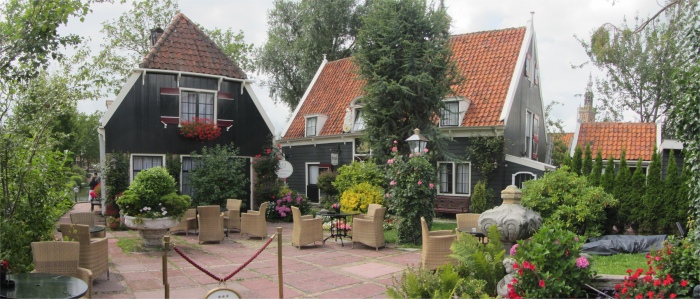
Hotel "De Fortuna"
|
On the southern side of the church beside the former entrance stood an annex called the Library. Originally it was probably used as a vestry, with the library on the floor above. Later it became the Latin School.
Outside the church lay the church yard peppered with well-kept gravestones. Many of the stones contained carvings or etchings giving not only the usual details of the deceased that can be found on British gravestones, but also a glimmer of the life of that person; an occupation or a hobby for example. One gravestone had a saw and hammer carved onto it indicating that the man who had died had been a carpenter. Another etching showed that the man who had died at the age of 40 had been a speed skater. Another person had been a drummer, and next to him the person had been a pilot. I had never come across such epitaphs before.
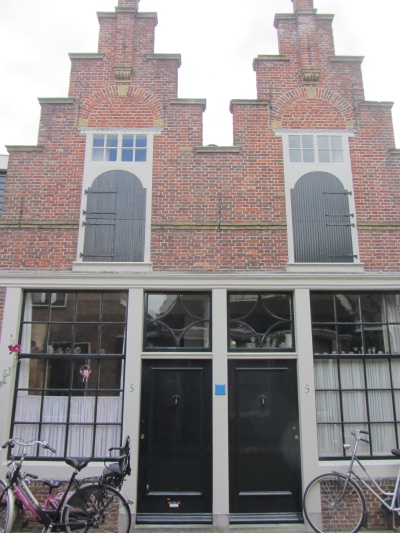
Early Semi-Detached Houses
|
After taking a sweeping view of the polder north of the church, we turned back towards town, and walked down Nieuwvaartje. This canal was dug in 1566 so that the ships carrying the cheese could easily reach the market from the Zeevang polder. Here, along Nieuwvaartje and along Groenland on the other side, there we many town farms, recognisable by their domed shapes. The pyramid shapes were created by the hay-barn: the high, square central part of the farm. The farmers who dwelt here owned land in the Zeevang polder and every spring, until quite recently, they would transport their cattle by boat from their farms to the meadows in the polder. In 1940, there were still seventeen farms in this street and on the other side.
My eye was caught by a frieze on the facade on No. 8, a brightly painted carving that revealed a short poem with small figures carved in relief. In the poem, a mermaid, caught by chance on a fishing trip, makes some erotic innuendoes which end in a conversation between a merman, with a bow and arrow, and a mermaid, with a wreath. The wooden carving's captions tell us that the world, the spirit of the nation and women are inscrutable riddles.
In Achterhaven we stopped off at the bakery for a welcome coffee and savoury pie. Next door, on the corner, stood the Oldest Wooden House in Edam. The lintel above the door with its decoration of late gothic accolade and rosettes indicated that the building dated from around 1530, and its almost total wooden construction with virtually original facade made this a rare example of gothic wooden architecture in the Netherlands.
We recrossed the Dam and took a stroll down the long, tree-lined Voorhaven to look at the old 18th century cheese warehouses. These lovingly restored buildings with their bell gables were also in Louis XIV style. As mentioned earlier, no cheese is made in Edam anymore.
Passing through yet more cobbled lanes, our vista opened out to another waterway, the Nieuwehaven. A stretch of wasteland on the opposite bank betrayed where an industrial area once resided. A hotchpotch of yachts and large, old, wooden, flat-bottomed working boats were moored cheek by jowl. The old boats with a large open working area were Botters - fishing boats. The enclosed boats, Tjalks, were once cargo barges. Like the houses, these were all owned and had been lovingly restored by private enthusiasts. Some have found a second life as charter boats.
Walking west along the Nieuwehaven, we came across the Hotel "De Fortuna" by the Constabelbrug. Two picturesque buildings stood here by the water's edge, completely rebuilt, using, amongst other things, views from picture postcards to reproduce copies of the small private school and wooden shed which formerly stood there.
